
Chronik Thailands
กาลานุกรมสยามประเทศไทย
von
Alois Payer
Chronik 1998 / B. E. 2541
3. Juli bis Dezember
Zitierweise / cite as:
Payer, Alois <1944 - >:
Chronik Thailands = กาลานุกรมสยามประเทศไทย.
-- Chronik 1998 / B. E. 2541. -- 3. Juli bis Dezember. -- Fassung vom
2017-03-20. -- URL:
http://www.payer.de/thailandchronik/chronik1998c.htm
Erstmals publiziert: 2012-10-25
Überarbeitungen: 2017-03-20
[Ergänzungen] ; 2016-04-18 [Ergänzungen] ; 2016-02-29 [Ergänzungen] ; 2016-02-08 [Ergänzungen] ; 2016-01-10 [Ergänzungen] ; 2015-06-07 [Ergänzungen] ; 2014-09-23 [Ergänzungen] ; 2014-04-10 [Ergänzungen] ; 2014-02-11 [Ergänzungen] ; 2013-05-24
[Ergänzungen] ; 2013-04-26
[Teilung des Jahrgangs]; 2013-04-20 [Ergänzungen]; 2013-04-17 [Ergänzungen]; 2013-04-07 [Ergänzungen]; 2013-04-03 [Ergänzungen]; 2013-01-28 [Ergänzungen]; 2013-01-26 [Ergänzungen]; 2013-01-13 [Ergänzungen]; 2012-11-21
[Ergänzungen]; 2012-11-18
[Ergänzungen]
©opyright: Dieser Text steht der Allgemeinheit zur Verfügung. Eine Verwertung in Publikationen, die über übliche Zitate hinausgeht, bedarf der ausdrücklichen Genehmigung des Herausgebers.
Dieser Text ist Teil der Abteilung
Thailand von
Tüpfli's Global Village Library
ช้างตายทั้งตัวเอาใบบัวปิดไม่มิด
|
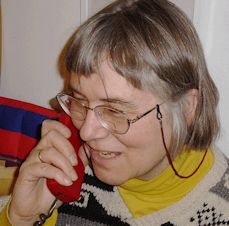
Gewidmet meiner lieben Frau
Margarete Payer
die seit unserem ersten Besuch in Thailand 1974
mit mir die Liebe zu den und die Sorge um die Bewohner Thailands teilt. |
 Vorsicht
bei den Statistikdiagrammen! Vorsicht
bei den Statistikdiagrammen!
Bei thailändischen Statistiken muss man mit allen Fehlerquellen rechnen, die in
folgendem Werk beschrieben sind:
Morgenstern, Oskar <1902 - 1977>: On the accuracy of
economic observations. -- 2. ed. -- Princeton : Princeton Univ.
Press, 1963. -- 322 S. ; 20 cm.
Die Statistikdiagramme geben also meistens eher qualitative als
korrekte quantitative Beziehungen wieder.
|
2541 / 1998 Juli bis Dezember
1998-07-02
Ein neues Geldwäschegesetz wird auf den
Weg gebracht. Danach ist die Strafe für der Geldwäsche schuldige Abgeordnete
und Senatoren doppelt so hoch wie für Normalbürger, die Strafe für schuldige
Mitglieder des Anti-Geldwäsche Komitees dreimal so hoch.
1998-07-14
Thaksin Shinawatra (ทักษิณ ชินวัตร) gründet die Thai Rak Thai Party (พรรคไทยรักไทย).

Abb.: ®Logo
[Bildquelle: th.Wikipedia]
| "The Thai Rak Thai Party (Thai:
พรรคไทยรักไทย, lit. Thais Love Thais; TRT) was a Thai
political party that was officially banned
on May 30, 2007, by the Constitutional Court of Thailand (ศาลรัฐธรรมนูญ) due to violations
of electoral laws during the 2006 legislative elections. From 2001 to 2006,
it was the ruling party under Prime Minister and its founder Thaksin
Shinawatra (ทักษิณ ชินวัตร). Eight months after a military coup forced Thaksin to stay in
exile, the party was dissolved on May 30, 2007 by the Constitutional
Tribunal for violation of electoral laws, with 111 former party members
banned from participating in politics for five years.[2]
Party
Platform and Electoral Outcomes
The Thai Rak Thai was registered on
July 15, 1998, by telecommunications entrepreneur Thaksin Shinawatra (ทักษิณ
ชินวัตร, 1949 - ) and 22
other founding members, including Somkid Jatusripitak (สมคิด
จาตุศรีพิทักษ์, 1953 - ), Thanong Bidaya (ทนง
พิทยะ, 1947 - ),
Sudarat Keyuraphan (สุดารัตน์ เกยุราพันธ์, 1961 - ), Purachai Piumsombun(ปุระชัย
เปี่ยมสมบูรณ์, 1950 - ), Thammarak Isaragura na Ayutthaya
(ธรรมรักษ์ อิศรางกูร ณ อยุธยา,
1938 - ),
and Prommin Lertsuridej (พรหมินทร์ เลิศสุริย์เดช, 1954 - ).
The Thai Rak Thai party had a populist platform, appealing to indebted
farmers – which had become indebted as a result of the Asian Financial
Crisis of 1997 – with promises of a strong economic recovery. The party also
reached out to rural villages, and struggling businesses. Thai Rak Thai's
policies have included a 30 Baht per hospital visit scheme, an extended debt
moratorium for farmers, 1 million Baht microcredit development funds for all
rural districts, and the One Tambon One Product project.
Thai Rak Thai won the legislative election of 2001 by a landslide margin
over the ruling Democrat Party led by Prime Minister Chuan Leekpai. 40% of
elected MPs were freshmen. Thai Rak Thai was also able to negotiate for a
merger with the New Aspiration Party and a coalition with the Thai Nation
Party, resulting in a majority of 325 out of 500 seats for the coalition
government.[3]
The Thai Rak Thai Party was the first political party in Thailand to have
been represented by more than half of the Members of the House of
Representatives. In the 2005 legislative election, the party's candidates
were elected to occupy 376 seats of the 500 seats in the House of
Representatives, defeating the largest opposition party, the Democrat Party.
It won 96 seats. After the election, Thailand's first single party
government was successfully formed.
In the invalid elections of April 2006, it won 61.6% of the vote and 460
out of 500 seats, the rest remaining vacant due to boycotting by the
opposition parties in the first past the post electoral system."
[Quelle:
http://en.wikipedia.org/wiki/Thai_Rak_Thai. -- ZUgriff am
2011-12-23]
|
1998-07-16


Abb.: Sanitsuda Ekachai (สนิทสุดา เอกชัย)
[Bildquelle: FAO]
Bangkok Post: Sanitsuda Ekachai (สนิทสุดา
เอกชัย, 1955 - ): "Monks
are the enemy within.
Kommentar zum "Weihwasser-Supermarkt"
von Phra Khru Sopitsutakhun, Wat Sanam Chan (วัดสนามจันทร์),
Chachoengsao (ฉะเชิงเทรา).
Der oberste Mönch von Monastic Region 12 verteidigt
Phra Khru Sopitsutakhun.
| "A Superman Buddha image. A holy water supermarket. Self-service
healing water. These gimmicks alone are enough to win Phra Khru
Sopitsutakhun a marketing award from the Temple Vultures
Association. But the enterprising abbot of Wat Sanam Chand has
many more lures to attract temple visitors and donations — like
amulets and holy water with the Chakri kings' royal titles,
paintings of naked people, and an image of Buddha’s disciple as a
communist killer. The Religious Department, as secretary to the
Ecclesiastic Council, is at its wits’ end how to tame this abbot’s
wild imaginings. The council will meet early next week to decide
what to do with the Buddha image resembling a ready-to-fly hero from
Japanese comics with the globe under one foot.
Critics say the unorthodox posture is offensive. They want it
demolished for fear other monks will copy the idea that the weirder
the Buddha image, the more the temple customers.
The controversial abbot has flatly rejected the demolition idea.
The image, he insists, is sacred because he built it at an angel’s
order. If the Sangha Council wants to dismantle it, he said, then
"do it yourself’. True to his entrepreneurial self, the abbot
laughed at bad press, which he sees as free publicity. The formerly
little-known Wat Sanam Chand in Chachoengsao is now on everyone’s
lips and the temple has never been so crowded. What goes on at Wat
Sanam Chand shows how crazy things can be when religious authorities
cannot control the commercialisation of Buddhism.
The holy water supermarket at Sanam Chand sells 200 brands of
bottled holy water made from the recipes of well-known monks
nationwide. "It saves the faithful trips," the abbot explained.
Attributes range from healing to business profits to bringing back
stray husbands. Nearby is a big tank containing "concentrate" of
holy water. If the goods on the shelf run out,
just mix the concentrate with rain water. And voila. The sick can
bathe in holy water by turning on the tap under the feet of a big
Buddha image which is actually a water tank.
I cannot help admiring his business ingenuity. He would make a
successful businessman should he leave the monkhood. And probably
that is what he should do to avoid doing farther damage to
Buddhism."
[Sanitsuda Ekachai (สนิทสุดา
เอกชัย) <1955 - >: Keeping the faith
: Thai Buddhism at the crossroads. -- Bangkok : Post Books, 2001. -- 322 S.
: Ill. ; 23 cm. -- ISBN 974-228-016-9. -- S. 303f.] |
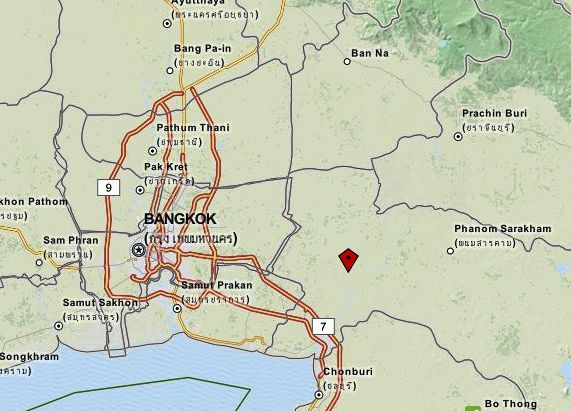
Abb.: Lage von Chachoengsao (ฉะเชิงเทรา)
[Bildquelle: OpenStreetMap. --
Creative
Commons Lizenz (Namensnennung, share alike)]
1998-07-17
Wegen der nationalen Geldknappheit
werden 5.000 Melonen-Arbeiter entlassen. Wenn nicht neues Geld ins System
kommt, droht mindestens 10 weiteren mittleren und kleineren Betreiben der
Kollaps wegen mangelnder Liquidität.
1998-07-17
In Bangkok öffnet das erste Starbucks
Coffee Shop Thailands. Bis 2007 folgen in ganz Thailand weitere 99 Filialen.
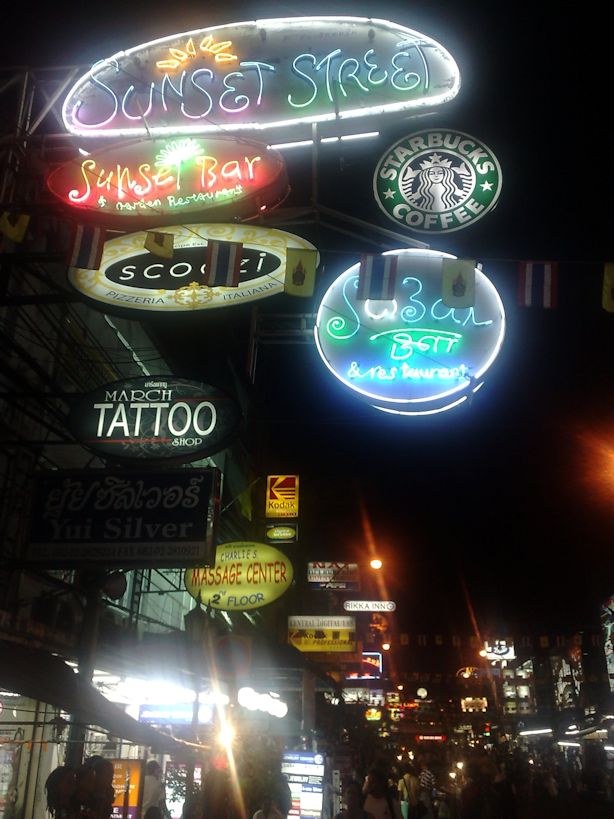
Abb.: Starbucks, Bangkok, 2008
[Bildquelle: Flickmor. --
http://www.flickr.com/photos/mmoorr/2180894357/. -- Zugriff am
2011-12-23. --
Creative Commons Lizenz (Namensnennung, keine kommerzielle Nutzung)]
1998-07-20
Der Direktor von Bangchak Petroleum (บางจากปิโตรเลียม
จำกัด), Sophon Suphapong (โสภณ สุภาพงศ,
1946 - ) erhält in Manila den Ramon Magsaysay Award for
Public Service.
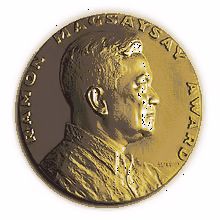
Abb.: ®Ramon Magsaysay Award
[Bildquelle: Wikipedia. -- Fair use]
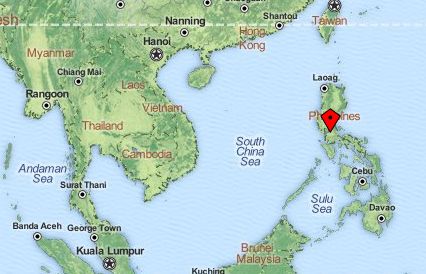
Abb.: Lage von Manila
[Bildquelle: OpenStreetMap. --
Creative Commons Lizenz (Namensnennung, share alike)]
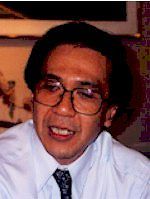
Abb.: Sophon Suphapong (โสภณ สุภาพงศ)
[Bildquelle:
http://www.rmaf.org.ph/Awardees/Citation/CitationSuphapongSop.htm. --
Zugriff am 2011-12-23]
"National economies
grow unevenly. As Southeast Asia's powerful centers surged ahead in
recent decades--Bangkok prominently among them--they captured the
lion's share of capital and jobs and new opportunities. To rural
areas the new wealth trickled down all too slowly, all the more so
after the region's long sustaining boom ended abruptly in 1997. Thai
business leader Sophon Suphapong (โสภณ สุภาพงศ)
thinks that economic growth that neglects the countryside is
unhealthy. As president of Bangchak Petroleum
(บางจากปิโตรเลียม จำกัด),
he has been stimulating Thailand's economy where he believes it
matters most: at the roots.
Born in 1946, Sophon spent part of his boyhood in Thailand's rural
southern provinces where his father served as governor. Despite its
elevated status, the family was extremely frugal. This was necessary
because Sophon's father refused to augment his meager government
salary by accepting bribes and other illicit sources of income.
"Honesty," he taught his son, "is the highest honor of a man's
life." Later, when for many years Sophon's father lay helpless in
the hospital with a debilitating nerve disease, Sophon asked
himself, "After a man dies, what is left of his name?" This thought,
he says, "established my way of life."
Sophon studied electrical engineering at Chulalongkorn University [จุฬาลงกรณ์มหาวิทยาลัย]
and then entered
the petroleum industry. In 1980, he was appointed deputy governor of
the Petroleum Authority of Thailand [การปิโตรเลียมแห่งประเทศไทย]
and assigned to manage a debt-laden oil refinery belonging to the
government. At the time, it was losing three million baht a day.
Sophon reorganized the company and restored it to profitability.
Renamed Bangchak Petroleum, it was soon one of Thailand's leading
oil providers. Sophon was named president in 1985.
Eager to expand Bangchak's distribution network and, at the same
time, to enliven the rural economy, Sophon began recruiting
agricultural cooperatives to be owner-operators of his company's
service stations. To help them, he guaranteed loans for purchasing
Bangchak franchises and sent his managers to teach neophyte dealers
how to run the new businesses. Today, cooperative societies, women's
groups, and other community organizations throughout Thailand own
and operate six hundred of Bangchak's twelve hundred service
stations. Many have also branched out into other Bangchak
enterprises such as petroleum delivery, clothing manufacture, and
service-station convenience stores called Lemon Green. Moreover,
farm-fresh produce is now available at many Bangchak outlets. Over a
million Thai households are now involved in these money-making
enterprises. Bangchak Petroleum has also profited from Sophon's
unconventional strategy. As one admirer puts it, "Bangchak's
national distribution network is the envy of its rivals."
Under Sophon's direction, Bangchak also promotes conservation and
environmental awareness in Thailand and is a leader in sponsoring
public interest television programs. When the country's new reform
constitution was being formulated in 1997, Sophon fostered public
debate by using Bangchak's network of service stations to distribute
the draft constitution nation wide. As a private citizen, he is
preoccupied with issues of poverty, child abuse, and his country's
democracy.
Sophon shuns the social whirl of Bangkok in favor of his many causes
and the quiet haven provided by his wife and two daughters. In the
current economic crisis, he worries about ordinary Thais. As
government-owned Bangchak faces privatization, Sophon fervently
asserts that the company's new owners should be Thais--even better,
rural Thais. "Economic power that lies in the hands of only five
percent of society . . . is not healthy," he says. A healthier
economy for Thailand's future will be based on "many small
businesses" throughout the country--businesses much like Bangchak's
rural gas stations and mini-marts.
In electing Sophon Suphapong to receive the 1998 Ramon Magsaysay
Award for Public Service the board of trustees recognizes his
stimulating Thailand's rural economy by helping hundreds of rural
cooperatives and community organizations own and operate their own
businesses as affiliates of a major Thai oil company."
[Quelle:
http://www.rmaf.org.ph/Awardees/Citation/CitationSuphapongSop.htm.
-- Zugriff am 2011-12-23]
|
| "Sophon Suphapong (Thai:
โสภณ สุภาพงศ) is
a former Senator for Bangkok in the National Assembly of Thailand and the
former President of Bangchak Petroleum. In 2005, Sophon accused the United States of being the
mastermind behind bombings in the South Thailand insurgency.
As a Senator, Sophon accused Prime Minister Thaksin Shinawatra (ทักษิณ
ชินวัตร) of taking
part in the Finland Plan (แผนฟินแลนด์, ยุทธศาสตร์ฟินแลนด์,
ปฏิญญาฟินแลนด์) and using gains from the privatization of state
energy company PTT in a plan to overthrow the Chakri dynasty and establish a
communist dictatorship. It
was revealed in April 2007 that Sophon was paid by the military junta to
criticize deposed Premier Thaksin Shinawatra following the 2006 Thailand
coup. However, Sophon continued to deny that he received any payment."
[Quelle:
http://en.wikipedia.org/wiki/Sophon_Supaphong. -- Zugriff am
2011-12-23]
|
1998-07-30
Es erscheint das Album
ไมค์
ภิรมย์พร [Mike Phiramphon]
<1970 - >:
ยาใจคนจน [Herzensbalsam der Armen]. -- Erschienen
1998-07-30. -- Es ist das fünfte Album des Sängers.
Das Album auf Spotify:
URI:
spotify:album:2nGEprfyrC4eXYuMxhg34h
URL:
https://open.spotify.com/album/2nGEprfyrC4eXYuMxhg34h
Bis 2000 werden angeblich über 1 Mio.
Kassetten verkauft
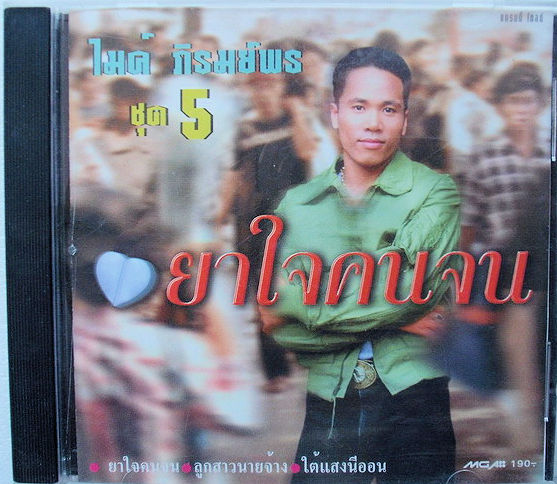
Abb.: CD-Hülle
[Fair use]
1998-08-26
In der Zeitung Daily News (เดลินิวส์)
erscheint ein Artikel "Wo ist die wahre Weiblichkeit geblieben?" (กุลสตรีอยู่ที่ไหน)
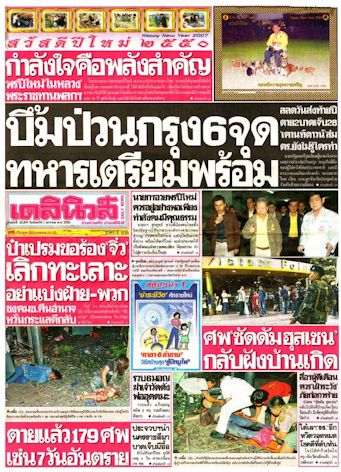
Abb.: Titelseite von Daily News (เดลินิวส์), 2007-01
| "Women are continually
subject to evaluations of their moral worth, based on culturally
embedded definitions of proper femininity, such as that embodied in
the notion of kunlasatri [กุลสตรี]"
The term means be a properly reared woman, "to be ladylike,"
implying that women should be patient, subservient, and docile. In
an essay entitled "Kunlasatri yuu nai?" (Where has proper femininity
gone?), a columnist wrote:
"Equality of the sexes and
rights and freedoms are good things, but one should not forget that
there are limits to them. No matter what, there will never be a day
when men and women can do all the same things. . . . Women letting
themselves go and following men’s behavior and not preserving their
proper femininity—society will look down on them and despise them,
and they will be ashamed wherever they go. Wait until you are born a
man before you do what men do, and while you are a woman, take care
of your proper femininity, and you will then be praised by whoever
sees you" (Daily News, August 26,
1998, 7)."
[Quelle: Sinnott,
Megan J.: Toms and dees : transgender identity and female
same-sex relationships in Thailand. -- Honolulu : University of
Hawaii Pr., 2004. -- 261 S. : Ill. ; 24 cm. -- ISBN
0824828526. -- Zugl. Diss., Univ. of Wisconsin
- Madison, 2002. -- S. 114.] |
1998-09-04

Larry Page (1973 - ) und Sergey Brin (Сергей
Михайлович Брин, 1973 - ) gründen Google
Inc. Seine Suchmaschine wird weltweit führend werden.

Abb.: ®Logo bis 2010-05-05
1998-09-10


Abb.: Sanitsuda Ekachai (สนิทสุดา เอกชัย)
[Bildquelle: FAO]
Bangkok Post: Sanitsuda Ekachai (สนิทสุดา
เอกชัย, 1955 - ): "Monks
and scandals : Is there no shame in being defrocked?"
Kommentar über die lasche Überprüfung von Kandidaten für den
Mönchsorden. So können sich kriminelle unter der Mönchsrobe verstecken.
Wegen der vielen Skandale will der stellvertretende ErziehungsministerArkom Engchuan
(อาคม
เอ่งฉ้วน, 1951 -
) einen Urintest auf Drogen vor der Zulassung zur Ordination obligatorisch
machen.
| "The urine test alone won’t produce any big changes. Only when
the Sangha returns to Buddha’s rules on screening ordinations and
the duties of preceptors will it win back public trust.
According
to the Vinaya, anyone with a contagious disease, namely
tuberculosis, leprosy, ringworms — even epilepsy — cannot be
ordained. Prospective monks also must be free of debt and not be
criminals. But criminals can now freely hide themselves behind
monks’ robes.
You might remember the monk last year who was a drug addict and
escaped convict who killed a British tourist. A recent
suicide/murder committed by a debt-ridden businessman who had
entered the monkhood to escape his financial woes also reflects the
Sangha’s lax screening methods.
As for the duties of preceptors, the Buddha rules they must
instruct the newly ordained for at least five years before they can
reside elsewhere. But being a preceptor has become a profession. You
ask a monk to ordain you, pay him a fee, and then go wherever you
please.
According to the Vinaya, monks who engage in sexual relations,
steal, kill or those who claim superhuman powers must be defrocked
and barred from re-entering the monkhood.
In the old days, defrocked monks wore a tattoo on their face, a
punishment for life. Now we no longer question monks who make money
or make a name by using black magic. And defrocked monks have become
cats with nine lives.
All this does not mean Arkom should not push ahead with the urine
tests. In fact, the tests should be expanded to cover all monks.
That would be one important step in cleaning up the Sangha."
[Sanitsuda Ekachai (สนิทสุดา
เอกชัย) <1955 - >: Keeping the faith
: Thai Buddhism at the crossroads. -- Bangkok : Post Books, 2001. -- 322 S.
: Ill. ; 23 cm. -- ISBN 974-228-016-9. -- S. 300] |
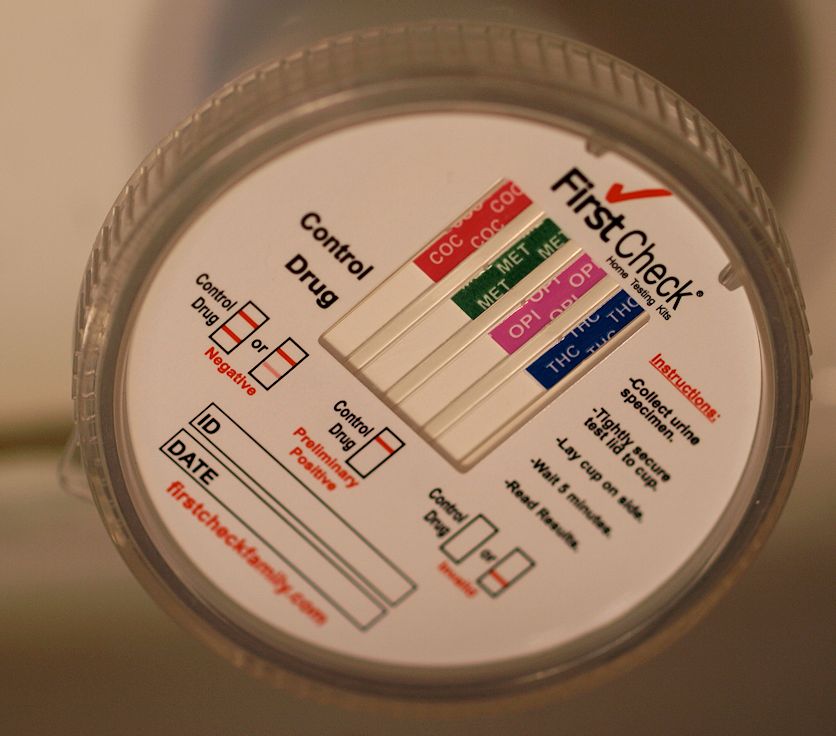
Abb.: Urin-Drogen-Schnelltest, 2008
[Bildquelle: Micah Baldwin. --
http://www.flickr.com/photos/micahb37/2970562310/. -- Zugriff am
2012-09-27. --
Creative
Commons Lizenz (Namensnennung, share alike)]
1998-09-14
Polizeirazzien zeigen, dass Bangkoks
Khaosan Road (ถนนข้าวสาร)
zu einem Paradies der Drogen wird.
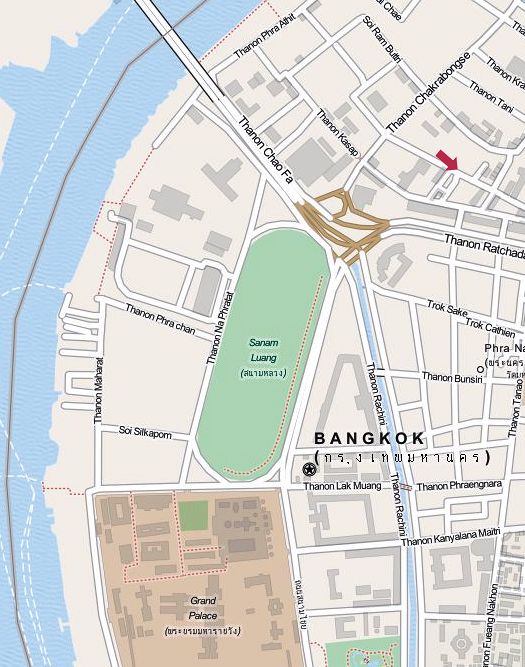
Abb.: Lage der Khaosan Road (ถนนข้าวสาร)
[Bildquelle: OpenStreetMap. --
Creative
Commons Lizenz (Namensnennung, share alike)]
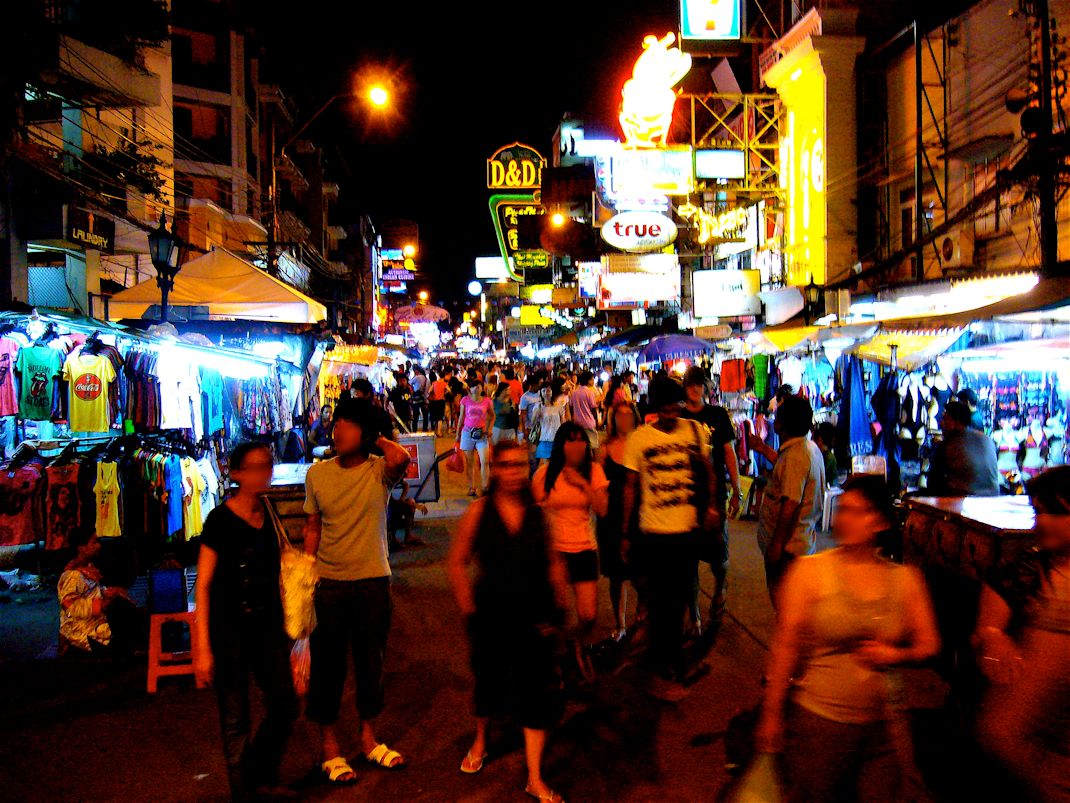
Abb.: Khaosan Road (ถนนข้าวสาร),
2008
[Bildquelle: Brandon Fick. --
http://www.flickr.com/photos/ficken/2947737282/. -- Zugriff am
2011-12-23. --
Creative Commons Lizenz (Namensnennung)]
| "Khaosan Road or Khao Sarn Road (Thai:
ถนนข้าวสาร)
is a short street in central Bangkok, Thailand. It is located in the
Banglamphu (บางลำภู) area of (Phra Nakhon district) about 1 km north of the Grand
Palace and Wat Phra Kaew. "Khaosan" translates as "milled rice", a
reminder that in former times the street was a major Bangkok rice market. In
the last 20 years, however, Khaosan Road has developed into a world famous "backpacker
ghetto". It offers cheap accommodation, ranging from 'mattress in a box'
style hotels to reasonably priced 3-star hotels. In an essay on the
backpacker culture of Khaosan Road, Susan Orlean called it "The Place to
Disappear." It is also a
base of travel: coaches leave daily for all major tourist destinations in
Thailand, from Chiang Mai (เชียงใหม่) in the North to Ko Pha Ngan
(เกาะพะงัน) in the South, and
there are many relatively inexpensive travel agents who can arrange visas
and transportation to the neighboring countries of Cambodia, Laos and
Malaysia, as well as Vietnam.
Khaosan shops sell handcrafts, paintings, clothes,
pirated CDs, DVDs, and second-hand books, plus many useful backpacker items.
Khaosan Road in recent years has become popular with
local residents, especially artists and art students. There are several pubs
and bars, where backpackers meet to discuss their travels. The area is
internationally known as a center of dancing, partying, and just prior to
the traditional Thai New Year (Songkran festival -
สงกรานต์) of April 13 to April 15,
water splashing that usually turns into a huge water fight. One Thai writer
has described Khaosan as "a short road that has the longest dream in the
world."[
A Buddhist temple under royal patronage, the centuries
old Wat Chana Songkram, is directly opposite Khaosarn Road to the west,
while the area to the northwest contains an Islamic community and several
small mosques."
[Quelle:
http://en.wikipedia.org/wiki/Khao_San_Road. -- Zugriff am
2011-12-23]
|
1998-09-16

Der Oberste Gerichtshof verwirft die
Berufung von Phra Bodhirak (Bodhirak, โพธิรักษ์,
1934 - ), Gründer von Santi Asoke (สันติอโศก),
und 79 seiner Anhänger. Phra Bodhirak war wegen
unberechtigten Tragens der Mönchskleidung und unberechtigter Ordination
anderer zu 54 Monaten Gefängnis auf Bewährung verurteilt worden, seine
Anhänger zu je drei Monaten auf Bewährung.
1998-09-16
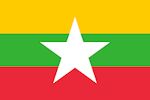
Öffnung des Grenzübergangs Myawaddy -
Mae Sot (မြဝတီမြို့
- แม่สอด)
für den Handel
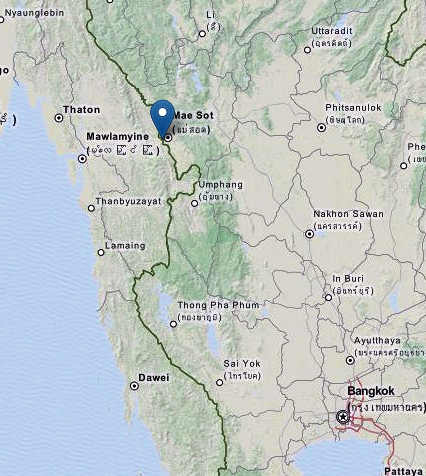
Abb.: Lage des Grenzübergangs Myawaddy - Mae Sot (မြဝတီမြို့
- แม่สอด)
[Bildquelle: OpenStreetMap. --
Creative
Commons Lizenz (Namensnennung, share alike)]
1998-09-18
Erstes internationales Film-Festival Thailands. Die Polizei
fordert, dass alle Filme zuvor der Zensur vorgelegt werden. Die Zensur
verbietet die Aufführung des Films "Bugis Street" (妖街皇后), da er
pornographisch sei. Der Film handelt über Transvestiten in Singapur.
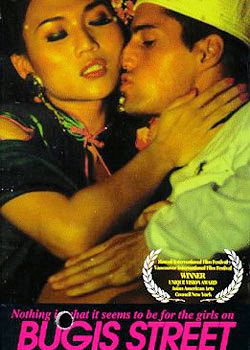
Abb.: Plakat
| "Bugis Street (妖街皇后) is a 1995 Hong
Kong-Singapore co-production directed by Yonfan (楊凡), about the lives of
Singaporean transvestites in a bygone era. It was a minor hit at the box
office with a sexually-explicit R(A) (Restricted (Artistic)) rating, male
full-frontal nudity and its nostalgic evocation of a seedy but colourful
aspect of Singaporean culture, prior to the redevelopment of Bugis Street
into a modern shopping district and the eradication of transvestite
activities in the area.
Synopsis
16-year old Lien, portrayed by Vietnamese actress Hiep
Thi Le, is the main protagonist. Despite her having worked for a time as a
servant in a household whose "young master" adored her in her hometown of
Malacca, West Malaysia, the young lass comes across as having led a
surprisingly sheltered life. She journeys to Singapore to seek employment as
a maid in the Sin Sin Hotel along Bugis Street.
She seems thoroughly content for a time to possess a
naïve, romanticised view of the rambunctious goings-on at the hotel where
she witnesses "the sad departure of an American gentleman" from the
home-cum-workplace of "his Chinese girl". The guest is actually a
presently-sober but angry American sailor who has belatedly discovered that
the Singaporean Chinese prostitute he picked up in Bugis Street and spent a
drunken night with happens to be a transwoman. Before long, the new employee
Lien finds out that many of the long-term lodgers of the budget
establishment, whose room rental rate is S$3, whether it be for an hour or
the entire day and night, are "women" who were born with male bodies.
Although her first reaction to seeing someone with breasts and a penis is
one of vomit-inducing revulsion which causes her to contemplate fleeing the
neighbourhood, she ends up not giving in to her impulses.
Instead, she listens to, then heeds, the warm cajoling
of Lola, the transvestite hotel resident who has treated her well from the
start of her stint. She comes to be unperturbed by the unique, complex
personalities of the unorthodox community, who in turn also begin to accept
her. As she learns to look beyond the surface, she is rewarded with the
generous friendship of the cosmopolitan and sophisticated Drago, who has
returned from Paris to minister to his/her dying but loving and tolerant
mother.
While Lien learns the ways of the world via her
encounters with Meng, the slimy, often underdressed boyfriend of Lola, as
well as night-time escapades on the town with the Sin Sin Hotel’s other
denizens, she begins to see beauty in unlikely places and to grow despite
the presence of ugliness in an imperfect world."
[Quelle:
http://en.wikipedia.org/wiki/Bugis_Street_%28film%29. -- Zugriff
am 2011-12-23]
|
1998-09-27
Es erscheint:
Nicholson-Lord, David:
Questioning some of the basic assumptions of development. -- In: Bangkok
Post. -- 1998-09-27
| "The extraordinarily rich
fisheries of the Mekong [ແມ່ນ້ຳຂອງ
/ แม่น้ำโขง
/ មេគង្]
and its tributaries [had] not only fed the fisherman and their
families. They provided a generous surplus to sell at market in
exchange for other foodstuffs and products the river could less
easily provide. And the lifestyle that went with this surplus was,
in many respects, a comfortable one—a matter of setting nets and
then, a few hours later, emptying them. No 12-hour grind in the
office for the fishermen of the Mekong. No three hours in a Bangkok
traffic jam either. Early mornings, maybe—but lots of clean air and
quiet, shady river- banks. Some people pay good money to holiday in
such places. And, somewhat poignantly, they were clear about what
they had lost. Their old way of life, they remarked, was one of ease
and leisure. No wonder they wanted it back."
[Zitiert in:
Fahn, James David <1965 - >:
A land on fire : the environmental
consequences of the Southeast Asian boom. -- Boulder : Westview, 2003. --
365 S. ; 24 cm. -- ISBN 0-8133-4267-8. -- S. 97f.] |
1998-09-28


Abb.: Sanitsuda Ekachai (สนิทสุดา เอกชัย)
[Bildquelle: FAO]
Bangkok Post: Sanitsuda Ekachai (สนิทสุดา
เอกชัย, 1955 - ): "Born
again"
Über Sutdya Vajrabhaya (วัชราภัย),
der seit sechs Jahren in Zusammenarbeit mit Jurgen Keil und Jim Tucker aus
dem Team des Reinkarnationsforschers Ian Stevenson (1918 - 2007)
Wiedergeburtserinnerungen in Thailand untersucht. Er glaubt 50 glaubwürdige
Fälle gefunden zu haben. Interessant ist, dass in vielen dieser Fälle der
vermeintlich Wiedergeborene nicht aufgrund von Karma wiedergeboren zu sein
glaubt.
"Reinkarnationsforschung untersucht Erinnerungen, die als solche an ein
früheres Leben interpretiert wurden. Dabei wird geprüft, ob sich der Fall als
Betrug, Selbstbetrug oder durch
psychologische,
parapsychologische oder
spiritistische Annahmen erklären lässt. Für so scheinbar nicht erklärbare
Fälle hält die Reinkarnationsforschung das Vorliegen einer tatsächlichen
Reinkarnation für möglich.Fallstudien
Von den 1960er Jahren bis kurz nach der
Jahrtausendwende untersuchte der Pionier der
Reinkarnationsforschung Ian Stevenson über tausend Fälle
von Kindern, die behaupteten, sich an frühere
Inkarnationen zu erinnern. Seine Untersuchungen finden
bei Reinkarnationsforschern besondere Beachtung.
Aufgrund der hohen Anzahl untersuchter Fälle mit
entsprechend hoher Validität genießen die Untersuchungen
Professor Stevensons bei einigen Fachleuten Anerkennung.
Beim phänomenologischen Vergleich der
Reinkarnation-Erinnerungen mit Berichten zu
Nahtodeserlebnissen (engl. near-death experience, NDE)
und den allgemeineren außerkörperlichen Erfahrungen (AKE;
engl. Out-of-the-body experience, abgekürzt OBE) ergeben
sich Hinweise auf einen gemeinsamen Kern.
Autoren wie Paul Edwards haben viele der von
Stevenson und anderen angeführten Fälle erneut
analysiert. Sie behaupten, dass genauere Untersuchungen
der betroffenen Individuen genügend Anhaltspunkte dafür
liefern, um die These zu schwächen, dass es sich um
glaubwürdige Beispiele von Reinkarnation handelt.
Als Fall vom Reinkarnationstyp (englisch: case of
the reincarnation type) bezeichnet Stevenson den
Fall einer Person, deren geäußerte Erinnerungen,
Verhalten oder auch körperliche Eigenschaften auf die
Möglichkeit eines früheren Lebens im Sinne der
Reinkarnation hindeuten (suggestive of reincarnation).
Einteilung der Fälle in Untertypen
Primär zu unterscheiden ist zwischen gelösten Fällen
(solved cases) und ungelösten (unsolved cases),
je nachdem ob eine verstorbene Person gefunden wurde,
auf die sich die vorhandenen Hinweise eindeutig
beziehen. Weitere Einteilungskriterien sind:
- Die frühere und die gegenwärtige Person können
derselben Familie angehören (same family cases)
oder nicht.
- Das Geschlecht der früheren und der
gegenwärtigen Person kann gleich oder verschieden
sein.
- Die Erinnerungen können auf unterschiedliche
Weise ausgelöst worden sein. Wissenschaftlich am
wertvollsten sind spontane Erinnerungen insbesondere
bei kleinen Kindern (dazu zählen die meisten von
Stevensons Fällen). Hypnotische Fälle hingegen
erwiesen sich für die Forschung nur in
Ausnahmefällen als nützlich. Ganz selten gibt es
Erinnerungen unter dem Einfluss von Meditation.
- Nach geographischen Gesichtspunkten lassen sich
nationale von internationalen Fällen unterscheiden.
Stevensons internationale Fälle, die nicht innerhalb
derselben Familie auftraten (im Zweiten Weltkrieg in
Birma getötete japanische Soldaten, an deren Leben
sich birmanische Kinder erinnerten), waren bisher
ausnahmslos ungelöst.
- Grundsätzlich ist auch noch zwischen Fällen mit
berühmten und unbedeutenden Vor-Inkarnationen zu
unterscheiden. Allerdings sind bisher nur wenige
Fälle wissenschaftlich untersucht worden, die auf
ein Vorleben als berühmte Persönlichkeit
hindeuteten, und diese konnten sämtlich als
offensichtlicher Betrug oder Selbstbetrug
identifiziert werden.
Einige Sonderfälle treten nur sehr selten auf:
- Xenoglossie: Kenntnisse fremder, im
gegenwärtigen Leben nicht erlernter Sprachen, die zu
einem erinnerten Vorleben passen.
- Zeitliche Überlappungen: Es sind einige Fälle
untersucht worden, bei denen der Tod der
identifizierten früheren Person nach der Geburt der
gegenwärtigen stattgefunden hat. Das Ausmaß beträgt
durchwegs nur wenige Tage. Im Fall Jasbir
(Indien) waren es dreieinhalb Jahre. In diesem Alter
starb Jasbir vermeintlich an den Pocken, erwachte
aber wieder und nahm danach die Persönlichkeit eines
22-jährigen Mannes an, der kurz zuvor in einem
anderen Dorf plötzlich verstorben war. Im Fall der
Inderin Sumitra Singh betrug die
Überlappungszeit sogar 17 Jahre. Zeitliche
Überlappungen der Schwangerschaft mit dem Leben der
später erinnerten früheren Person treten häufiger
auf.
- Für die Forschung besonders interessant sind
Fälle, in denen schriftliche Protokolle über die
Äußerungen eines Kindes gemacht wurden, bevor man
begann, sie zu überprüfen.
- Ebenfalls bedeutend sind Fälle, die in einem dem
Reinkarnationsglauben feindlichen kulturellen Umfeld
auftreten. Die wichtigsten Beispiele dafür waren
Moslem-Kinder in Indien, die sich an ein Vorleben
als Hindus erinnern.
Beobachtungen, die für die Forschung relevant sind
Folgende Elemente spielen in Fällen von
Reinkarnationstypen für die Forschung eine wichtige
Rolle:
- Erinnerungen, die sich verifizieren lassen:
Diese sind umso bedeutender, je unwahrscheinlicher
es ist, dass die sich erinnernde Person die
erinnerten Informationen auf gewöhnlichem Weg
erfahren haben könnte. Deshalb wird der Möglichkeit
früherer Kontakte zwischen den beiden betroffenen
Familien große Aufmerksamkeit gewidmet.
- Verhaltens-Eigenschaften, die im Zusammenhang
mit dem erinnerten Vorleben psychologisch sinnvoll
sind. Dazu zählen:
- Phobien, also Furcht vor Dingen, die der
Vorinkarnation Schaden zufügten, insbesondere
vor solchen, die mit ihrem gewaltsamen Tod im
Zusammenhang stehen (beispielsweise gegen Wasser
bei einer Erinnerung an einen Tod durch
Ertrinken).
- Philien, also Zuneigungen zu Dingen, die
schon für die Vorinkarnation mit Lustgewinn
verbunden waren (z. B. bestimmte Speisen)
- emotionale Beziehungen zu bestimmten
Personen in gleicher Weise, wie sie der oder die
Verstorbene zeigte oder in einer vergleichbaren
Situation wohl gezeigt hätte
- kollektive Freund-Feind Beziehungen, wie sie
z. B. im Nationalismus oder der Blutrache zum
Ausdruck kommen
- religiöse Einstellungen und die Intensität
der Religiosität
- Sprechgewohnheiten
- Besitzansprüche auf das Eigentum der
Vorinkarnation
- das soziale Selbstverständnis
- geschlechtsspezifische Verhaltensweisen bei
Geschlechtswechsel
- sexuelle Verhaltensweisen
- Spiele von Kindern, die früheren (privaten
oder beruflichen) Tätigkeiten entsprechen
- der hygienische Standard
- allgemeine Charaktereigenschaften (z. B.
Mut)
- Ankündigungen. Entweder äußert sich die frühere
Person vor ihrem Tod über ihre Wünsche hinsichtlich
der Wiedergeburt in einer bestimmten Familie, oder
es treten Ankündigungsträume der späteren Mutter
oder einer nahestehenden Person auf, die zumeist
eine Anfrage des Verstorbenen zum Inhalt haben, ob
er willkommen ist. Wegen der Möglichkeit der
Beeinflussung durch eine solche Ankündigung ist der
wissenschaftliche Wert angekündigter Fälle
vergleichsweise niedriger einzustufen.
- Körperliche Merkmale und Besonderheiten im
Zusammenhang mit dem Vorleben: Dazu zählen
Muttermale, aber auch angeborene Fehlbildungen an
Stellen früherer (und häufig tödlicher)
Verletzungen. Für die Forschung ist dies wichtig,
weil sich solche körperliche Phänomene völlig
objektiv und unstrittig feststellen lassen.
Stevenson hat eine große Zahl derartiger
birthmarks fotografiert.
[...]
Die
Erklärungsversuche
Einzelfälle
Jeder Fall ist individuell daraufhin zu untersuchen,
welche Erklärung für ihn am wahrscheinlichsten zutrifft.
- Betrug: Der bekannteste höchstwahrscheinlich
betrügerische Fall war der eines israelischen
Kindes, das sich an ein Vorleben als König David
erinnert haben soll. Nachprüfungen zeigten, dass der
Fall praktisch zur Gänze frei erfunden war. Klar
betrügerische Fälle sind sehr selten, weil es für
sie kaum eine nennenswerte Motivation gibt. Die
häufig geäußerte Vermutung, die Betreffenden
versuchen, durch die Erfindung eines reichen oder
berühmten Vorlebens ihre soziale Position zu heben,
ist in Bezug auf die Länder Südasiens
gegenstandslos, in denen die meisten untersuchten
Fälle auftraten: Nach dem dort herrschenden
Karma-Glauben ließe ein sozialer Abstieg nur auf
schwere Verfehlungen im Vorleben schließen.
- Selbstbetrug: Es gibt Fälle, die sich am
leichtesten dadurch erklären lassen, dass Eltern
Äußerungen ihres Kindes missverstanden und sich in
ihrer Phantasie einen Fall zusammengereimt haben.
Das bekannteste Beispiel dafür ist eine angebliche
Reinkarnation des amerikanischen Präsidenten Kennedy
in dem kurz nach seinem Tod geborenen Türken Kenedi
Alkan (sein Vorname ist die türkische Schreibweise
von Kennedy).
- Kryptomnesie: Unter Kryptomnesie versteht man
eine Schein-Erinnerung an Dinge, deren
Informationsquelle man vergessen hat. So kann ein
historischer Roman oder Film den Inhalt einer
vermeintlichen Erinnerung an ein Vorleben bilden.
- Paramnesie: (siehe Paramnesie) Fehlerhafte
Erinnerungen von Eltern an das, was ihre Kinder
bezüglich ihrer Vorinkarnationen sagten, könnten
auftreten, nachdem Nachforschungen (bzw. Kontakte
mit der früheren Familie des Kindes) neue
Informationen erbracht hätten. Durch Vergleiche von
Zeugenaussagen verschiedener Informanten und
derselben Personen zu verschiedenen Zeiten (über
Jahre hinweg) schließt Ian Stevenson, dass
Gedächtnisfehler zumeist kein ernstes Problem
darstellen. Um Paramnesie völlig auszuschließen, ist
es wichtig, vor dem Beginn von Nachforschungen die
noch unverifizierten Aussagen zu protokollieren.
- genetisches Gedächtnis: Dies ist eine oft
geäußerte, aber unbewiesene Erklärung. In den
meisten Fällen lebt das Kind in einer Familie,
welche mit der Familie der früheren Person nicht
genetisch verwandt ist. Somit entfällt das Argument,
soweit es sich auf individuelle, nicht kollektive
Erinnerungen bezieht. Zu den am häufigsten
geschilderten Ereignissen gehört der Tod der
früheren Person. Das Wissen um den eigenen Tod kann
schlechterdings nicht vererbt werden. Das genetische
Gedächtnis (die genetische Übertragung von Wissen)
ist bei vielen Tieren zu beobachten, vor allem aber
bei Insekten (Spinnen lernen nicht, wie man Netze
spinnt, sondern tun es automatisch).
- außersinnliche Wahrnehmung: Bei der
außersinnlichen Wahrnehmung (ASW) handelt es sich um
ein parapsychologisches Phänomen, über dessen
Existenz in der Wissenschaft noch kein Konsens
besteht. Die starke Identifikation einer Person mit
einer ganz bestimmten Verstorbenen kann es nicht
erklären. Überdies schneiden Menschen mit
Erinnerungen an frühere Leben bei Messungen ihrer
ASW-Fähigkeiten nicht besser ab als der
Durchschnitt.
- Besessenheit: Die Besessenheit ist ein
spiritistisches Modell, das annimmt, der Geist eines
Verstorbenen beeinflusse die lebende Person oder
verdränge sie vorübergehend. Für beide Varianten
gibt es in der Parapsychologie je einen
Vorzeige-Fall, der sie dringend nahezulegen scheint.
Es sind dies der Fall Thompson-Gifford und das
bekannte Watseka-Wunder. Allerdings weisen die
meisten Fälle vom Reinkarnationstyp wenig Züge der
Beeinflussung eines Menschen durch einen anderen
auf, und eine Verdrängung geht in Reinkarnation
über, wenn sie das ganze Leben vorhält.
- Reinkarnation: Für alle jene Fälle, deren
Erklärung auf eine bisher genannte Weise nicht
möglich oder extrem unplausibel wäre, vermutet die
Reinkarnationsforschung das Vorliegen einer
tatsächlichen Reinkarnation, da auch weitere
Alternativen, die in der weiterführenden Literatur
genannt werden, nicht recht überzeugen können."
[Quelle:
http://de.wikipedia.org/wiki/Reinkarnationsforschung.
-- Zugriff am 2012-09-24]
|
1998-10

Japan schafft den Miyazawa Fund (งบมิยะซะวะ -
โครงการเงินกู้กระตุ้นเศรษฐกิจ
/ 宮沢基金), der u.a. Thailand zwei Jahre lang 200 Mio. Baht als
zinsgünstige Anleihe zur Verfügung stellt. Der Fund ist benannt nach dem
japanischen Politiker Kiichi Miyazawa (宮澤
喜一, 1919 - 2007). Der Fund soll vor
allem befristete Arbeitsmöglichkeiten für innerthailändische
Arbeitsmigranten schaffen, die durch die Finanzkrise 1997 ihren Arbeitsplatz
verloren haben.
1998-10-01 - 2002-09-30
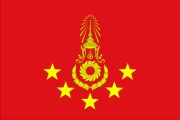
General Surayud Chulanont (พลเอก สุรยุทธ์ จุลานนท์,
1943 - )
ist Commander-in-Chief of the Royal Thai Army (ผู้บัญชาการทหารบก).
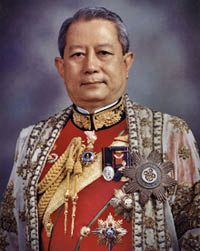
Abb.: Surayud Chulanont (พลเอก สุรยุทธ์ จุลานนท์)
[Bildquelle: th.Wikipedia. -- Public domain]
1998-10-02
Premiere des Films 303 Fear Faith Revenge
(303 กลัว/กล้า/อาฆาต)
von Somching Srisupap (สมจริง ศรีสุภาพ)
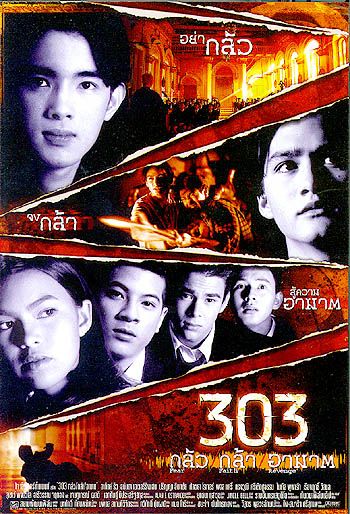
Abb.: Plakat
[Bildquelle: Wikipedia. -- Fair use]
|
303 Fear Faith Revenge
(Thai: 303
กลัว/กล้า/อาฆาต, RTGS: 303 Klua/Kla/Akhat)
is a 1998 Thai horror film starring Taya Rogers (เทย่า โรเจอร์ส, 1985 -
), Artid Ryu (อาทิตย์ ริว, 1978 - ), and Ananda Everingham (ອນນັດາ
ເອເວອຣິ່ງແຮນ /
อนันดา เอเวอริ่งแฮม).
In this film, an investigation into a star student's suicide results in
several students being stranded in their closed school where they are
hunted and killed one-by-one."
[Quelle:
http://en.wikipedia.org/wiki/303_Fear_Faith_Revenge.
-- Zugriff am 2013-04-20]
|
1998-10-10
Ein Alternative Love Film Festival
sollte an der Chulalongkorn Universität (จุฬาลงกรณ์มหาวิทยาลัย)
stattfinden. Die Universität beansprucht Vorzensur der Filme, deshalb werden
die Filme "privat" bei der extra dafür geschaffenen Film Lovers Association
gezeigt. Mitgliedschaft erhält man mit dem Kauf eines Filmticket. Der Chef
des Film Departement der Universität, der auch in der staatlichen
Zensurbehörde sitzt, schickt Polizei zur Veranstaltung. Der Polizist drückt
aber ein Auge zu und verlässt die Veranstaltung mit der Bemerkung, er habe
nichts Unmoralisches gesehen.
Gezeigt werden Filme wie Bugis Street
(妖街皇后) (1995)
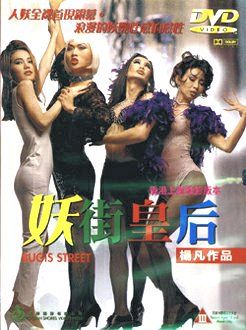
Abb.: ©DVD-Cover
| "Bugis Street (妖街皇后) is a 1995
Hong Kong-Singapore co-production directed by Yonfan, about the
lives of Singaporean transvestites in a bygone era. It was a minor
hit at the box office with a sexually-explicit R(A) (Restricted (Artistic))
rating, male full-frontal nudity and its nostalgic evocation of a
seedy but colourful aspect of Singaporean culture, prior to the
redevelopment of Bugis Street into a modern shopping district and
the eradication of transvestite activities in the area."
[Quelle:
http://en.wikipedia.org/wiki/Bugis_Street_%28film%29. -- Zugriff
am 2014-09-23] |
1998-10-25
Tod des Literaturprofessors der
Chulalongkorn University, Pleuang na Nakorn (เปลื้อง ณ นคร aka. นายตำรา ณ
เมืองใต้ aka ป. ณ นคร, 1909 - 1998)
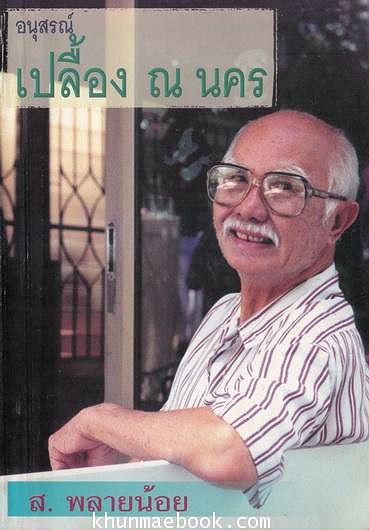
Einbandtitel des Gedenkbuchs, 1998
[Fair use]
1998-10-27
Panwong Hirunchai, ein Day-Trip Manager
in Phuket (ภูเก็ต), wird in seinem Büro von einem
Gewehrschützen schwer verwundet. Der Täter bleibt unbekannt.
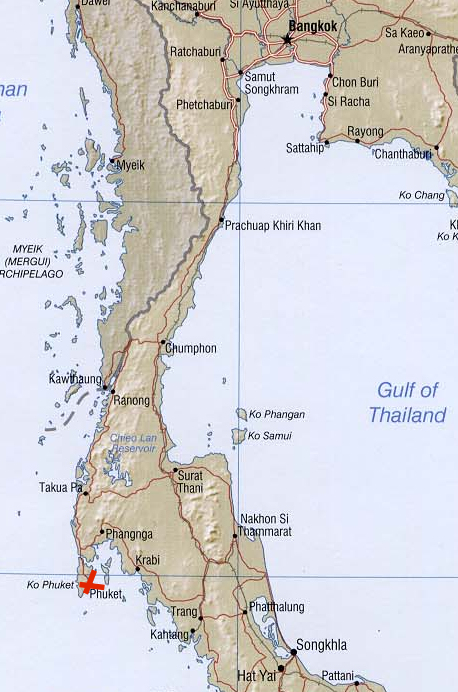
Abb.: Lage von Phuket (ภูเก็ต)
[Bildquelle: CIA. -- Public domain]
1998-10-30
Der Film O-Negative (รัก-ออกแบบไม่ได้)
wird bei Jugendlichen ein Hit. Filmemacher: Chakrit Yamnam (ชาคริต แย้มนาม,
1978 - ). Schauspieler: Tata Young (ทาทา
ยัง, 1980 -), Ray McDonald (เรย์
แมคโดนัลด์, 1977 - ), Sharit Yamnam (ชาคริต แย้มนาม, 1978 - ), Mansawee
Krittanakul (มนัสวี กฤตานุกูลย์). Regiseur: Pinyo Rutham (ภิญโญ รู้ธรรม,
1957 - ).
Filmongs auf Spotify:
URI:
spotify:album:66vN9B1eBAKq4VQpxp994L
URL:
https://open.spotify.com/album/66vN9B1eBAKq4VQpxp994L
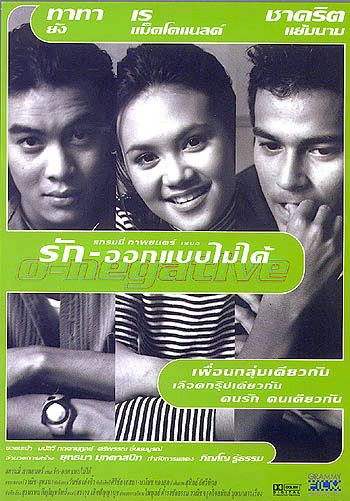
Abb.: Plakat
[Bildquelle: th.Wikipedia. -- Fair use]
1998-10-30

Die Polizei beschlagnahmt 750.000 Pillen
Ya Ba [ยาบ้า]
im Haus des Dealers Surachai Ngernthongfu, alias Bang Ron. Bang Ron entkommt
nach Myanmar.
1998-11
Auch das ist in Thailand möglich:
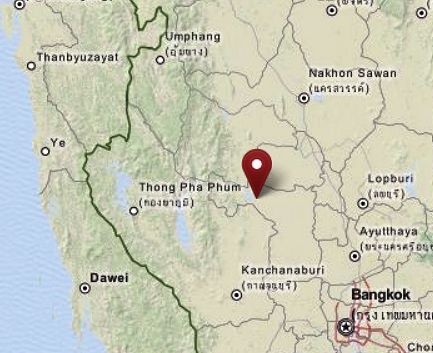
Abb.: Lage von Amphoe Dan Chang [ด่านช้าง]
[Bildquelle: OpenStreetMap. --
Creative
Commons Lizenz (Namensnennung, share alike)]
| "Banharn's [Banharn Silpa-archa
- บรรหาร
ศิลปอาชา,
1932 - ]efficiency was clearly demonstrated during the construction of a
school in one remote village (named Ta Pherm Khi) of Dan Chang
District [ด่านช้าง] in 1998. Located in a
mountainous area near the border with Uthai Thani Province [อุทัยธานี]
and some 190 kilometers away from the provincial capital,
this village, inhabited by about two hundred minority tribe people (Karens
[กะเหรี่ยง])
from forty-one families, had long been the poorest village of all in
Suphanburi [สุพรรณบุรี].
The level of education attained by its residents was also the lowest
in Suphanburi, since the village did not have even a primary school.
In November 1998, Banharn visited this village to inspect its
conditions firsthand. His subsequent action was extraordinarily
swift. He called Dilok Phatwichaichoot, then chief of the Provincial
Office of Primary School Education, and ordered him to build a new
primary school with four classrooms in this village within
seventy-two hours. Since this order came out of the blue, Dilok did
not have enough construction funds to carry it out. To overcome this
problem, Banharn told Dilok to get the construction materials by
dismantling a building that was no longer being used at Wat Makham
Tao School in the neighboring Derm Bang Nang Buat District [เดิมบางนางบวช].
As a provincial longju [Teochew:
shop owner, manager],
Banharn knew exactly which school buildings were
no longer used and where they were located. Then he ordered the
Provincial Administration Organization and the Provincial Offices of
Highways and Accelerated Rural Development to provide manpower and
trucks in transporting the dismantled materials to Ta Pherm Khi
village over a distance of some sixty kilometers. As road
construction agencies, the latter two civil service offices have
nothing to do with school construction, but Banharn's power over
bureaucratic appointments and budget allocations allowed him to
mobilize their human and material resources smoothly without being
fettered by bureaucratic red tape. At Banharn's behest, Dilok hired
fifty-three workers to undertake the construction of the new school
on three shifts, twenty-four hours a day.
Thanks to this around-the-clock work schedule,
which entailed the mobilization of numerous civil servants and
laborers, the construction of the first school in Ta Pherm Khi was
completed in just fifty-nine hours."
[Quelle: Nishizaki, Yoshinori [訳吉武好孝,
西崎一郎]: Political authority and
provincial identity in Thailand : the making of Banharn-buri. -- Ithaca, N.Y. :
Cornell, 2011. -- 254 S. :Ill. ; 26 cm. -- (Studies on Southeast Asia ; 53). --
ISBN 978-0-8772-7753-8 . -- S. 130]
|
1998-11

Es erscheint
Feingold, David A.:
Sex, Drugs and the IMF: Some Implications of "Structural
Readjustment" for the Bade in Heroin, Girls and Women in the Upper
Mekong Region. -- In: Refuge : Canada’s Journal on Refugees. -- 71,5
(1998-11). -- Online:
http://refuge.journals.yorku.ca/index.php/refuge/article/view/21984/20653.
-- Zugriff am 2016-02-29
|
Our research
has found that the entry of girls into sex work involves a complex
of interlocking networks - both formal and informal, commercial and
non-commercial - criss-crossing borders throughout the Upper Mekong
region.
There is a
flow of females moving north in one area; south in another. Tai Neu
[Tai Nüa: ᥖᥭᥰᥖᥬᥳᥑᥨᥒᥰ]
- girls go into China while Dai [ᥖᥭᥰ]
girls from the Sip Song Panna [ᦈᦹᧈᦈᦹᧈᦋᦵᦲᧁᦘᦱᦉᦱᦑᦺ᧑᧒ᦗᧃᦓᦱ
/ Xishuangbanna /
西双版纳傣族自治州]
region of China travel down through Burma to Thailand. Some are
actually kidnapped and/or sold; that is, "trafficked", in the
traditional sense of the term. Others are victims of deception
promised restaurant, household or factory jobs, only to be lured or
forced into sex work. Most, however, make "voluntary" choices to
start their journeys, though these choices are often predicated upon
harsh economic conditions at home and scant knowledge of the outside
world.
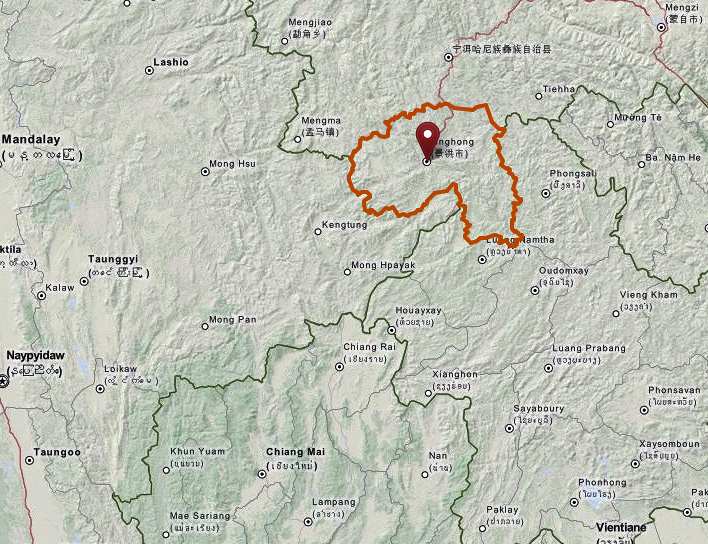
Abb.: Lage von Sip Song Panna [ᦈᦹᧈᦈᦹᧈᦋᦵᦲᧁᦘᦱᦉᦱᦑᦺ᧑᧒ᦗᧃᦓᦱ
/ Xishuangbanna /
西双版纳傣族自治州]
[Bildquelle: OpenStreetMap. --
Creative
Commons Lizenz (Namensnennung, share alike)]
Research
indicates that most are not so much fleeing abject poverty and
political oppression (as in Burma), but chasing a better, more
exacting life. Much of the impetus can be described as the lure of
"bright lights, big city." Many of the girls believe that the
streets of Thailand are "paved with gold;" that life is more
exciting than in their villages; and that they will be part of a
dominant population, instead of a minority as they are in China.
Part of the "push factor" is the "to get rich is glorious" [致富光荣]
attitude that permeates China, in which rural people see themselves
as shut out of the opportunities for material advancement.
However they
start out, in the course of their journey to Thailand, the women
frequently come to depend on one or more of these networks.
We have
located the Luk Moo [ลูกหมู]
(Piglet) Network, who are responsible for about 50 percent of the
girls and women smuggled into Thailand from Shan States [မိူင်းတႆး],
China and Laos to work in brothels.
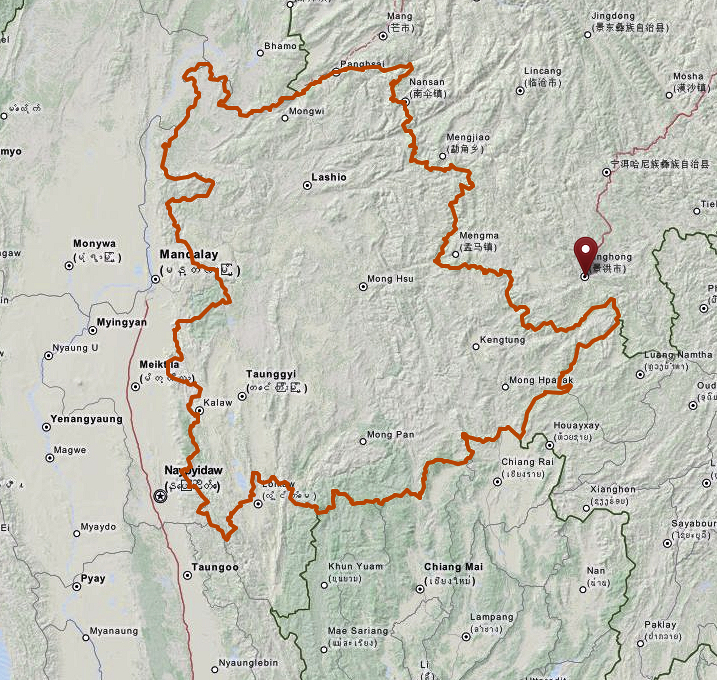
Abb.: Lage des Shan State [မိူင်းတႆး]
[Bildquelle: OpenStreetMap. --
Creative
Commons Lizenz (Namensnennung, share alike)]
There are
also other networks, such as the Kabuankarn Loy Fah [ขบวนการลอยฟ้า]
("Floating in the sky" Network) specializing in girls for
restaurants and Karaoke bars.
Much like
illicit drug networks, each of these networks depends on financing
and political protection to operate. Standard bribes must be paid to
move girls across borders and through police checkpoints. Profit
maximization dictates transporting girls through the fewest numbers
of checkpoints. This is the great appeal of using the Mekong River [ 澜沧江
/ မဲခောင္မ္ရစ္
/ ແມ່ນ້ຳຂອງ
/ แม่น้ำโขง].
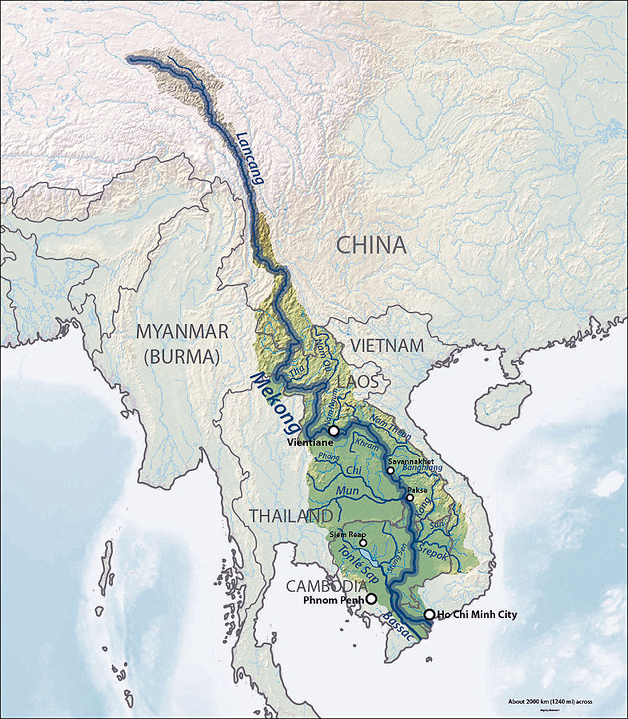
Abb.: Lauf des Mekong [ 澜沧江
/ မဲခောင္မ္ရစ္
/ ແມ່ນ້ຳຂອງ
/ แม่น้ำโขง]
[Bildquelle: Shannon1 / Wikimedia. --
Creative Commons Lizenz (Namensnennung, share alike)]
The Piglet
network has tried a variety of means to smuggle girls to supply to
the brothels. Although the Mekong River transport has been halted,
the Piglets have turned to overland trafficking routes through
Tachilek [တာချီလိတ်]
(Burma) to Mae Sai [แม่สาย]
(Thailand). From there, girls can be moved around the country, some
are traded all the way to Malaysia. The Piglet financier never
involves himself directly in trafficking. He assigns agents to work
on his behalf, but if an agent is arrested by the police, the
financier will intervene-using his political power to secure the
agent's release.
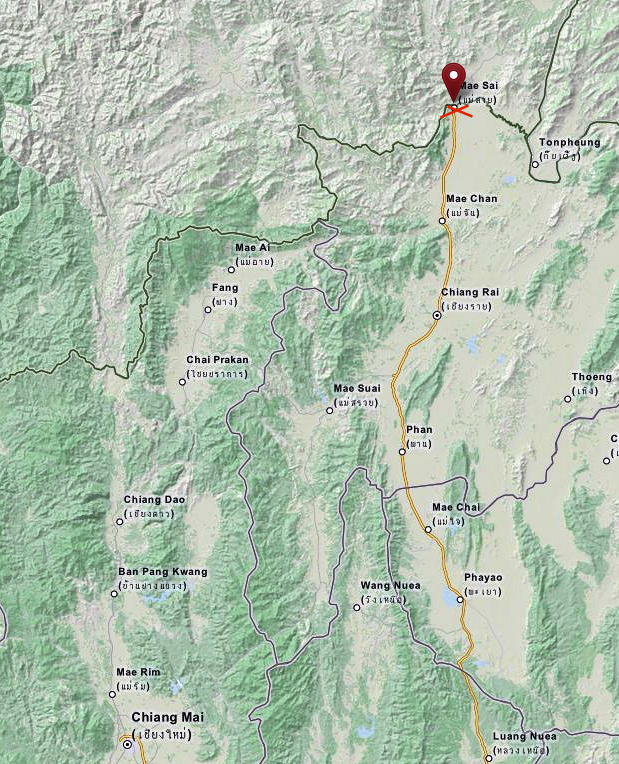
Abb.: Lage von Tachilek [တာချီလိတ်]
(Myanmar) und Mae Sai [แม่สาย]
(Thailand)
[Bildquelle: OpenStreetMap. --
Creative
Commons Lizenz (Namensnennung, share alike)]
Over the past
eighteen months, changes have taken place, which have resulted in a
movement from so-called direct sex work (brothels) to indirect sex
work. This has resulted in better working conditions for the women
in the North, but created more of a public health problem because of
less control.
Thailand is
the only country in the region to bring its HIV infection rate under
control. In Burma, Laos, and China, HIV infection rates are
climbing, but in Thailand new infections have fallen dramatically in
the last five years. (Of course, the number of AIDS cases is still
increasing at a horrifying rate due to past HIV infections.) Even in
Thailand, however, new threats are emerging because of the economic
crisis. One cornerstone of the Thai pubic health success has been
the distribution of free condoms by the Ministry of Public Health.
This program is now at risk because of budget cuts, and medical
officials fear that it will not survive the year."
[a.a.O. -- Fair use] |
1998-11-05
Trotz Protesten von Umweltschützern darf
der Hollywood-Film "The Beach" auf Koh Phi Phi (เกาะพีพี)
gedreht werden.
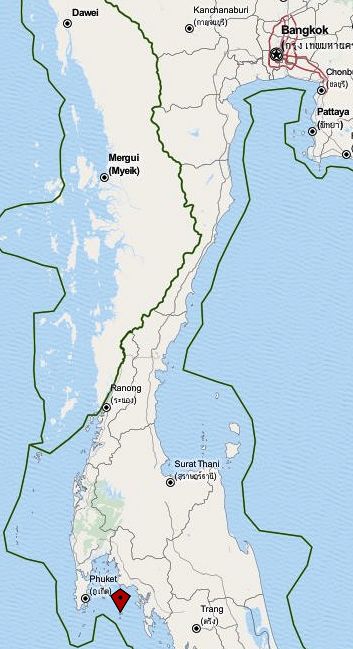
Abb.: Lage von Koh Phi Phi (เกาะพีพี)
[Bildquelle: OpenStreetMap. --
Creative
Commons Lizenz (Namensnennung, share alike)]
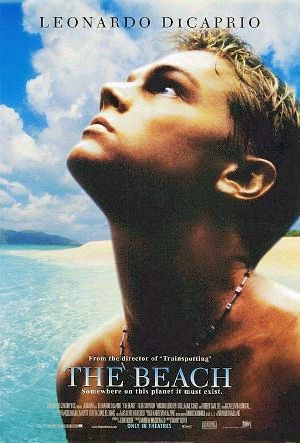
Abb.: Plakat
[Bildquelle: Wikipedia. -- Fair use]
| "The Beach, zu Deutsch Der Strand, ist ein Film
von Danny Boyle aus dem Jahr 2000. Der Film beruht auf dem Roman
Der Strand (Originaltitel: The Beach) des Engländers
Alex Garland über eine abenteuerliche Rucksackreise in Thailand. Das
Buch erschien 1996."
[Quelle:
http://de.wikipedia.org/wiki/The_Beach. -- Zugriff am
2011-12-23] |
1998-11-07

Geburt der Hündin des Königs, S. g. Thong Daeng (คุณ
ทองแดง).
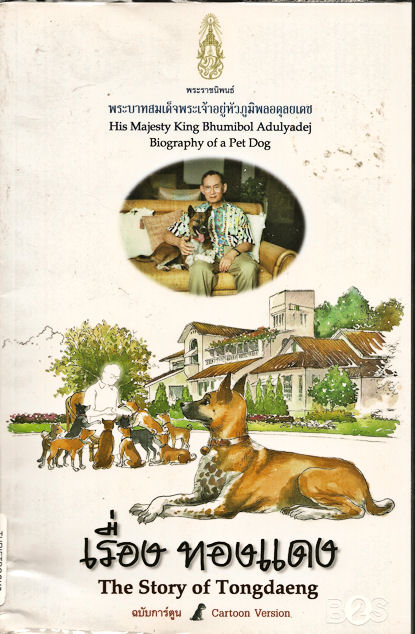
Abb.: Einbandtitel
| "Thong Daeng, (Thai:
คุณทองแดง) a female
copper-colored dog, is one of the pets owned by King Bhumibol Adulyadej of
Thailand. Bhumibol adopted Thong Daeng in 1998 from the litter of a stray dog
that had been taken in by a medical center he had recently dedicated. Her name
means "copper" in Thai. Bhumibol called her "A common dog who is uncommon," and in
2002 wrote an affectionate biography of her titled "The Story of Thong Daeng
(เรื่อง ทองแดง)". The book is commonly referred to as a parable on many social
topics. For instance, the King wrote that "Tongdaeng is a respectful dog with
proper manners; she is humble and knows protocol. She would always sit lower
than the King; even when he pulls her up to embrace her, Tongdaeng would lower
herself down on the floor, her ears in a respectful drooping position, as if she
would say, 'I don't dare.'"
All the names of the dogs owned by the King start with the
word "Thong" (lit. gold).
The book instantly sold out in Thailand. Since demand was
so high, the book became an esteemed gift. Shortages of the book had to be kept
down by multiple reprints.
Literature
- HM King Bhumibol Adulyadej of Thailand. The Story
of Tongdaeng. Amarin, Bangkok. 2004. ISBN 974-272-917-4"
[Quelle:
http://en.wikipedia.org/wiki/Thong_Daeng. -- Zugriff am
2012-06-15 |
1998-11-14
Die Thai Zensur verärgert mit ihren
Vorschriften die Hollywood-Produzenten von "Anna and the King" so, dass der
Film statt in Thailand in Malaysia gefilmt wird. Thailand verliert so $20
Mio an Spesen, die die Filmleute ausgegeben hätten.
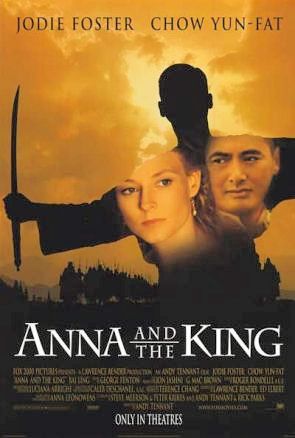
Abb.: Plakat
[Bildquelle: Wikipedia. -- Fair use]
1998-11-14
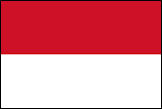
Jakarta (Indonesien): schwere
Ausschreitungen gegen und Plünderungen von Einrichtungen und Geschäften
chinesischstämmiger Indonesier.
1998-11-26


Abb.: Sanitsuda Ekachai (สนิทสุดา เอกชัย)
[Bildquelle: FAO]
Bangkok Post: Sanitsuda Ekachai (สนิทสุดา
เอกชัย, 1955 - ): "Our
head hurts and demands attention"
Kommentar zu Mönchen in Wat Yai Intaram
(วัดใหญ่อินทาราม),
Chonburi, die jeden mit Rache bedrohten, der ihre nächtlichen Saufgelage dem
kranken Abt verrate. Der Schatzmeister der Klosters, Rak Supong bricht sein
Schweigen, nachdem ihn ein betrunkener Mönch, dem er gedroht hatte, es dem
Abt zu melden, ein Messer in den Bauch gestochen, seine Frau am Rücken und
seinen Sohn an der Hand verletzt hatte. Ebenso darüber, dass 200 Mönche die
Polizeistation in Suphan Buri belagerten und die Freilassung von Phra Singto
von Wat Muang Jaroenpol, Suphan Buri (สุพรรณบุรี),
verlangten. Phra Singto wird beschuldigt, ein neunjähriges Mädchen sexuell
missbraucht zu haben. Der Tempel unterzog daraufhin das Mädchen einer
feindseligen und erniedrigenden Befragung, aufgrund derer der Abt des
Klosters die Beschuldigung zurückwies. "The news of monks grilling the
traumatised girl to protect their own kind makes me mad."
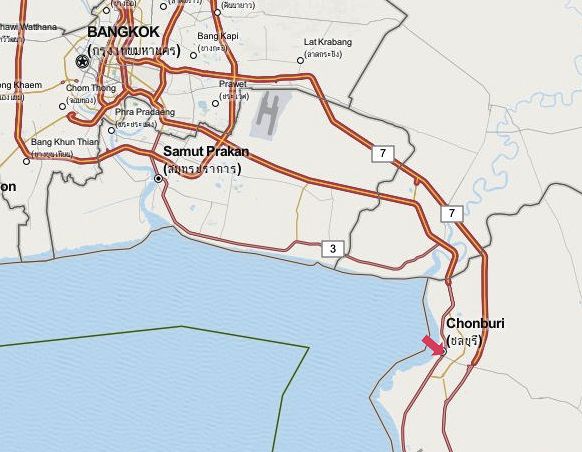
Abb.: Lage von Wat Yai Intaram (วัดใหญ่อินทาราม)
[Bildquelle: OpenStreetMap. --
Creative
Commons Lizenz (Namensnennung, share alike)]
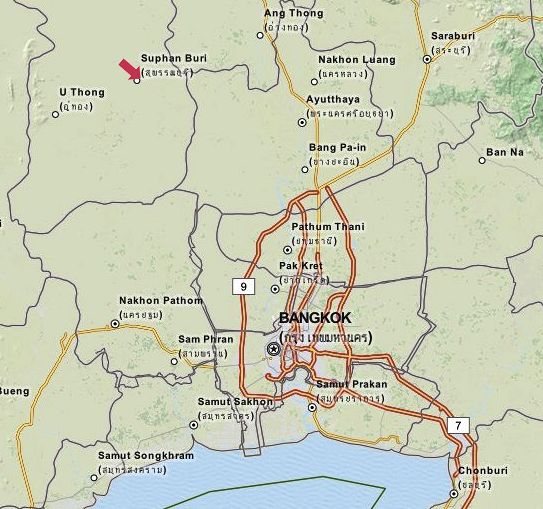
Abb.: Lage von Suphan Buri (สุพรรณบุรี)
[Bildquelle: OpenStreetMap. --
Creative
Commons Lizenz (Namensnennung, share alike)]
1998-12-03


Abb.: Sanitsuda Ekachai (สนิทสุดา เอกชัย)
[Bildquelle: FAO]
Bangkok Post: Sanitsuda Ekachai (สนิทสุดา
เอกชัย, 1955 - ): "The
Dhammakaya saga : we are best off teaching ourselves"
Kommentar zum Erfolg der
Dhammakaya-Bewegung (ธรรมกาย).
| "The popularity of Dhammakaya relies on our
desire for an eternal heaven where merit can be bought and
accumulated like frequent flier points. As Buddhists who cannot rely
on cleric authorities, we must learn the essence of Buddha’s
teachings ourselves. Otherwise, our spirituality will continue to be
exploited." [Sanitsuda Ekachai (สนิทสุดา
เอกชัย) <1955 - >: Keeping the faith
: Thai Buddhism at the crossroads. -- Bangkok : Post Books, 2001. -- 322 S.
: Ill. ; 23 cm. -- ISBN 974-228-016-9. -- S. 282] |
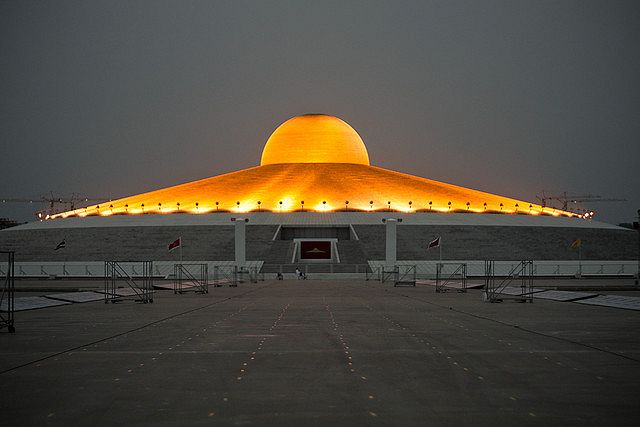
Abb.: Wat Phra Dhammakaya (วัดพระธรรมกาย),
Pathum Thani (ปทุมธานี)]
[Bildquelle: Horsemilk / Wikimedia. -- GNU FDLicense]
1998-12-06 - 1998-12-20
13th Asian Games in Bangkok. Thailand gewinnt 24 Gold-, 26
Silber- und 40 Bronzemedaillen. In der Gesamtwertung steht Thailand an 4.
Stelle.

Abb.: Maskottchen
[Bildquelle: Wikipedia. -- Fair use]
1998-12-10


Abb.: Sanitsuda Ekachai (สนิทสุดา เอกชัย)
[Bildquelle: FAO]
Bangkok Post: Sanitsuda Ekachai (สนิทสุดา
เอกชัย, 1955 - ):
What is in it for us women?"
Kommentar. Ergebnis: Die Sikkhamart
("Nonnen") von Santi Asoke (สันติอโศก)
sind zwar diskriminiert, haben aber mehr Rechte als die traditionellen Mae
Chee (แม่ชี).
Dhammakaya (ธรรมกาย)
dagegen sei so chauvinistisch wie der
traditionelle Mönchsorden.
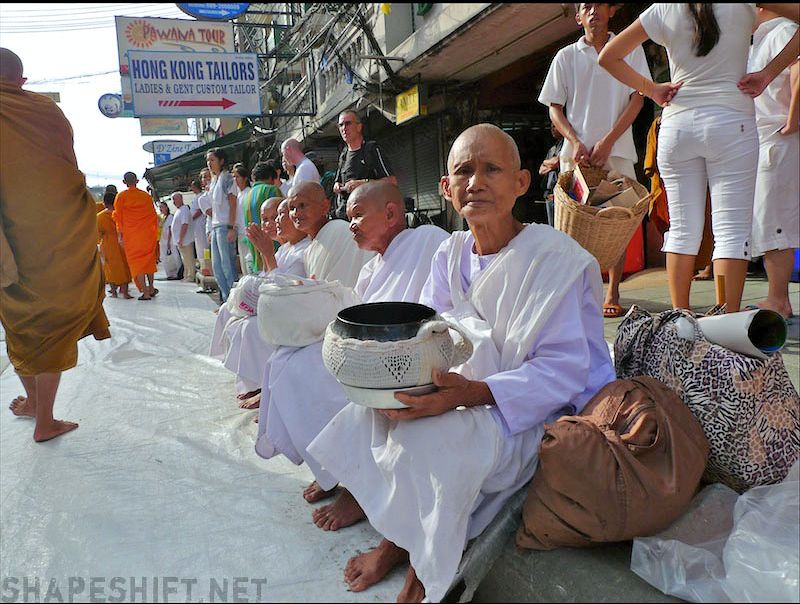
Abb.: Mae Chee (แม่ชี),
Bangkok, 2009
[Bildquelle: david pham. --
http://www.flickr.com/photos/shapeshift/3479416014/. -- Zugriff am
2012-09-27. --
Creative Commons Lizenz (Namensnennung, keine kommerzielle Nutzung,
share alike)]
1998-12-11
Beim Landeversuch auf dem Flughafen von
Surat Thani (สุราษฎร์ธานี)
stürzt ein Flugzeug der Thai Airways ab. 101 Tote. Die Untersuchung ergibt,
dass das Instrumentenlandesystem des Flughafens schon seit über zwei Jahren
abgeschaltet ist und dass die Hälfte der Landebahn-Leuchten nicht in Betrieb
sind.
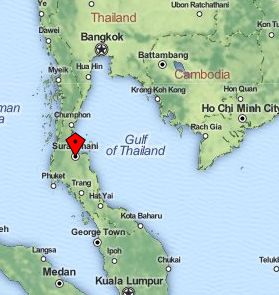
Abb.: Lage von Surat Thani (สุราษฎร์ธานี)
1998-12-19
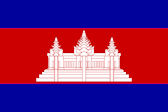
Die beiden Schwerstverbrecher der Roten
Khmer (ខ្មែរក្រហម),
Khieu Samphan (ខៀវ សំផន,
1931 - ) und Nuon Chea (នួន
ជា, 1926 - ), laufen zur Regierung über
und bitten um Vergebung für ihre Schreckensherrschaft. Sie sagen, man solle
einen Schlussstrich unter die Vergangenheit setzen.
1998-12-19 - 1999-01-12

Impeachment-Verfahren
(Amtsenthebungs-Verfahren) gegen US-Präsident Bill Clinton wegen Meineids über
seine Oralsex-Affaire mit Monica Lewinsky (1973 - ). Das Verfahren endet mit
Freispruch für den Präsidenten.
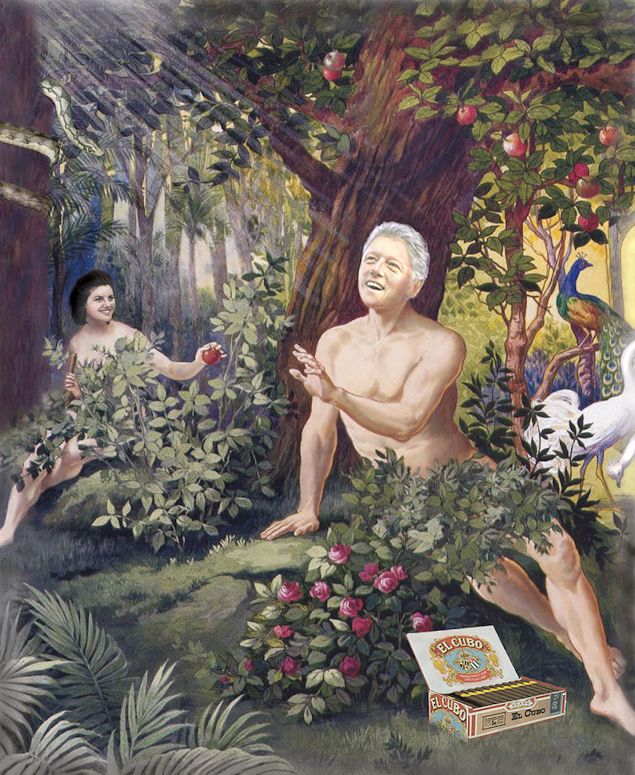
Abb.: Bill Clinton und Monica Lewinsky
[Bildquelle:
kokopelli67. --
http://www.flickr.com/photos/73957035@N00/2763524895/. -- Zugriff am
2013-05-24. --
Creative Commons Lizenz (Namensnennung)]
1998-12-30
Thailändische Schulkinder sind verrückt nach Tamagotchi's
(たまごっち).

Abb.: Tamagotchi (たまごっち)
[Bildquelle: David / Wikimedia. -- Public domain]
| "Das Tamagotchi (jap.
たまごっち,
Wortschöpfung aus tamago (dt. „Ei“) und wotchi (von
engl. watch, dt. „Uhr“)) ist ein aus Japan stammendes
Elektronikspielzeug, das in der zweiten Hälfte der 1990er Jahre
weltweit populär war und im Jahr 2004 wieder neu aufgelegt wurde.
Spielprinzip
Das Tamagotchi stellt ein virtuelles Küken dar, um das man
sich vom Zeitpunkt des Schlüpfens an wie um ein echtes Haustier
kümmern muss. Es hat Bedürfnisse wie Schlafen, Essen, Trinken,
Zuneigung und entwickelt auch eine eigene Persönlichkeit. Zu
unterschiedlichen Zeitpunkten meldet sich das Tamagotchi und
verlangt nach der Zuwendung des Besitzers. Sollte man es
vernachlässigen, stirbt es, kann jedoch durch Drücken eines
Reset-Schalters wiederbelebt werden, und das Spiel geht von vorne
los. Dies ist in allen Versionen möglich, auch wenn es Gerüchte gab,
dass die japanische Version des Tamagotchi nur einen einzigen
Lebenszyklus zulassen würde.
Abmessungen
Das Tamagotchi ist etwa 5,5 cm hoch, 4 cm breit und 1,5 cm dick.
Das Display hat eine Auflösung von 32 × 16 Pixel (Original-Version).
Geschichte
Das Tamagotchi wurde 1996 von der Bandai-Mitarbeiterin Aki Maita
(真板 亜紀, Maita
Aki) als Idee in einer Abteilungssitzung vorgestellt und im
Hause Bandai (株式会社バンダイ)
entwickelt. Zunächst nur auf dem japanischen Markt, wenig später
durch Importe, Plagiate und Konkurrenzprodukte auch in Europa und
den USA wurde das kleine Plastik-Ei binnen weniger Monate zum Kult,
der allerdings relativ kurzlebig war. Nach Deutschland kam das
Tamagotchi am 12. Mai 1997. Lieferengpässe begünstigten den Handel
auf dem Schwarzmarkt. Es dauerte nicht lange, bis verschiedene
Hersteller teils günstigere Konkurrenzprodukte anboten, die dann oft
einen größeren Funktionsumfang als das Original boten. Allerdings
konnte auch die zweite, verbesserte Original-Version des Spielzeugs
die Zielgruppe zwischen 14 und 17 nicht lange beeindrucken – nach
wenigen Monaten war der „Tamagotchi-Rausch“ wieder vorbei. Einige
Computerhersteller haben auf dem Spielprinzip basierend Varianten
für den PC, Macintosh und Gameboy entwickelt. Im Internet wurden von
Fans des Spielzeugs gar virtuelle Friedhöfe für die Tamagotchis
eingerichtet."
[Quelle:
http://de.wikipedia.org/wiki/Tamagotchi. -- Zugriff am
2011-12-23] |
Verwendete Ressourcen
ausführlich:
http://www.payer.de/thailandchronik/ressourcen.htm
Zu Chronik 1999 / B. E. 2542. -- 1. undatiert



















































